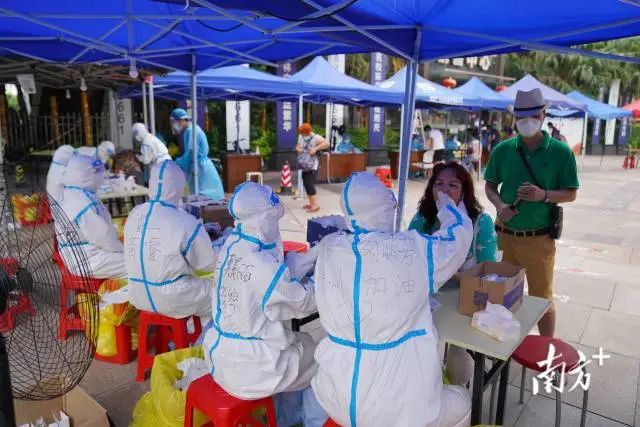-
Company News
-
Industry News
-
Exhibition Information
-
hot sale oxygen concentrator News
-
oxygen concentrator 10lpm News
-
two flowmeter oxygen concentrator News
-
Ozone Disinfector News
-
oxygen machine hospital News
-
low noise oxygen concentrator
-
oxygen concentrator 10lpm
-
5l oxygen concentrator
-
hospital use oxygen concentrator
-
oxygen concentrators
About the epidemic, Zhong Nanshan latest research judgment!
- Categories:Industry News
- Author:
- Origin:
- Time of issue:2021-06-28 17:42
- Views:
(Summary description)
About the epidemic, Zhong Nanshan latest research judgment!
(Summary description)
- Categories:Industry News
- Author:
- Origin:
- Time of issue:2021-06-28 17:42
- Views:
About the epidemic, Zhong Nanshan latest research judgment!
COVID-19 epidemic situation in Guangdong Province
From 0:00 on June 25 to 24:00 on June 25, there were no new local confirmed cases or local asymptomatic infected people in the province.
There were 4 newly imported confirmed cases in the province, including 1 from South Africa reported in Shenzhen. One case from Saudi Arabia was reported in Zhuhai. One case, from Saudi Arabia, was reported in Foshan; One case, from Liberia, has been reported in Jiangmen. Nine new cases of asymptomatic infections were imported from abroad, including four cases reported in Guangzhou from Bangladesh, Japan, Cambodia and Qatar. Two cases, one from Tanzania and one from Saudi Arabia, have been reported in Foshan. One case, from French Guiana, has been reported from Dongguan; Two cases, one from Benin and the other from Gabon, were reported in Zhongshan. 12 patients were newly discharged from hospital.
As of 24:00 on June 25, a total of 2,727 confirmed cases of COVID-19 (1161 cases imported from overseas) have been reported in the province. At present, 181 cases are in hospital.
Guangzhou will complete a new round of full nucleic acid before June 30

On June 25, at the press conference on epidemic prevention and control in Guangzhou, Chen Bin, deputy director and spokesman of Guangzhou Municipal Health Commission, announced that no new cases of domestic infections had been reported in Guangzhou from 0 to 24 o 'clock on June 24, which was the sixth consecutive zero new cases. Before June 30, the city will complete a new round of full nucleic acid screening. Guangzhou Yuexiu and many other places have opened the hall food
On June 25, Yuexiu, Baiyun, Zengcheng and Nansha districts in Guangzhou issued a notice to resume in-store food service.
To 23.20 p.m., 25:
Canton Panyu, Haizhu, Yuexiu and Zengcheng districts resumed canteen;
In Baiyun District, except for No. 3, Ji 'an Street, Jixian Road, Yongping Street, and No. 109, Jixian Road, in medium-risk areas, hall food was resumed in other areas.
In addition to Jia 'an Garden on Pearl River Street, east of Lingxin Avenue on Pearl River Street, south of Gongye Road No.1 Lane, and north of Liuyong District in Nansha District, in-room food service units (including food sales units providing in-room food) in other areas of the whole district will resume in-room food service from June 26;
Whampoa requires that the tables in the lobby should not exceed 70%, and those in the lobby of Tianhe and Huadu should not exceed 50%. Among them, there is no midnight snack from 22:00 to 5:00 the next day.
The remaining 2 districts, Liwan, Conghua still require the entire district to ban in-room food restaurants.
Shenzhen has grounded a total of seven routes and eight inbound passenger flights
On the afternoon of June 25, Shenzhen held a press conference on epidemic prevention and control. In order to prevent the outbreak, Shenzhen has suspended seven air routes and eight inbound passenger flights since the outbreak, said Wu Bing, a member of the municipal government's Party leadership group and second-level inspector. CA868, the South African flight from Johannesburg to Shenzhen, has been cut off as soon as possible.
The results of a new round of nucleic acid screening in the sealed and controlled area of Dongguan were all negative
Dongguan yesterday, Ma Chung, South City, East City of the closed control area of about 380,000 people, the latest round of nucleic acid screening results are all negative. As of 24 PM Thursday, a total of 13,0884 million doses of vaccine had been administered in Dongguan, and 5.5958 million people had been vaccinated in two doses.
Zhong Nanshan: In response to the Delta strain, the previous concept of "close contacts" needs to be changed

How to judge the current situation of the local epidemic in Guangdong? What is the good experience of Guangdong in dealing with the first community spread of novel coronavirusDelta strain in China? In the next stage, how should Guangdong do a good job in epidemic prevention and control? On June 25, Zhong Nanshan, a recipient of the Medal of the Republic and an academician of the Chinese Academy of Engineering, gave an interview to the media and made the latest assessment on the local epidemic in Guangdong.
Zhong Nanshan believes that Guangdong Province has achieved good initial results in preventing and controlling the first community-based transmission of Novel Coronavirus Delta strain in China. Guangdong's experience will be helpful to the prevention and control of the epidemic throughout the country. On the epidemic situation:
The risk of spillover of the "June 14" epidemic to surrounding communities in Shenzhen should be highly vigilant
Reporter: What is your judgment on the current situation of prevention and control of the local epidemic in Guangdong?
ZHONG Nanshan: Since May 21, there have been three local clusters of outbreaks caused by novel coronavirus variants imported from abroad in Guangdong.
The first was a localized cluster of alpha-mutated strains in Yantian District of Shenzhen on May 21. Since June 6, there have been no new cases of infection for 18 consecutive days, and the epidemic has been completely controlled.
The second outbreak occurred in Liwan District of Guangzhou and related cities on May 21, which was caused by the Delta variant strain and was confined to 22 towns in 4 cities including Guangzhou, Foshan, Zhanjiang and Maoming. As of 24 June, a total of 167 cases of infection have been reported.
The third outbreak was caused by Delta mutation at Shenzhen Airport on June 14. So far, 7 cases have been reported, including 4 cases in Shenzhen and 3 cases in Dongguan.
The delta-variant strains in Shenzhen and Guangzhou had different mutation sites and were of different origin. The epidemic in Guangzhou has been effectively controlled, but the epidemic in Shenzhen has not been effectively controlled. We need to be highly vigilant about the risk of spillover to surrounding communities and further spread to other areas and provinces, as well as the risk of causing transmission within schools. Reporter: What are the characteristics of the new Coronet Delta strain? How do you evaluate the progress of prevention and control of the local epidemic in Guangzhou?

Zhong Nanshan: First of all, compared with the common wild-type strain, the viral load in infected people was 100 times higher than that of the common strain.
The second is that the Delta strain has a short incubation period in the body, about 1-3 days. The average incubation period of novel coronavirus in last year's epidemic in Wuhan was 3-7 days.
The Delta strain also takes a long time to turn negative in the body. From our observation in Guangzhou, the time for the virus to turn negative in the body is 13-15 days, a few can reach more than 20 days, much longer than the common strain of 7-9 days, almost twice as high.
Because the infected person has a high viral load, this strain is more than twice as infectious as the normal strain. In the early days of the epidemic, five generations of transmission occurred within 10 days, with a transmission index of 4.04-5.0. According to this index, if we had not taken effective measures, the model predicted that about 7.3 million people would have been infected in Guangzhou during the same period.
After several adjustments to the prevention and control plan, there has been no new infection in Guangzhou community since June 19. It took less than one month from the beginning of the epidemic to the realization of "zero new cases". It can be said that the epidemic in Guangzhou has been effectively controlled initially.
In my personal judgment, China has achieved significant results in the first phase of the campaign against the spread of the Delta strain in the community during the Guangzhou epidemic.
On Guangdong's Prevention and Control Experience:
The "yellow code" system was established nationwide for the first time
Correspondent: What are the good and innovative practices of Guangdong in this "head-on confrontation" with Delta strain?
Zhong Nanshan: In addition to learning the effective prevention and control methods adopted in Beijing, Guangdong has adopted some innovative and scientific management measures according to the characteristics of Delta virus infection.
First, we quickly identified the source of infection and identified the chain of transmission. After receiving the report on May 21, the same afternoon, Guangzhou identified the source of the infection. We did genetic testing for the strain in all the cases, which is not done elsewhere. Through genetic testing, we found that the case is the first case of the infection of the old woman infected, the transmission chain is very clear. Genetic sequencing gives us very clear data on where the epidemic is headed and how to manage it.
Second, in the case of the Delta strain, the concept of the communicator was changed. Delta strain has high viral load, high exhaled virus concentration of infected people, and increased transmission, so the old concept of close contact no longer applies. In the past, it was the family members of the infected person 2 days before the onset of the disease, colleagues in the office, and people who ate or had meetings with the infected person within 1 meter, which were considered close contacts. For the Delta variant strain, those who had been together with the infected person in the same space, the same unit, the same building four days before the onset of the infection were all close contacts. Due to the change of concept, we have formulated different management and control modes, such as closed and sealed control.
Third, Guangdong set up a "yellow code" system for the first time in the country. Through the communication of big data, the movement tracks of people who have been to key areas are retrieved, given yellow codes, and the public security department is closely coordinated. Yellow code personnel must complete nucleic acid testing within 24 hours. Combined with measures such as "two tests in three days" and "three tests in seven days", more accurate monitoring can be achieved to a certain extent. Through the above measures, out of 167 cases in the transmission chain in Guangzhou, 53 cases were found without symptoms, accounting for 31.7%. It was a very important innovation, and it was very targeted, and it helped bring the epidemic under control very quickly.
Fourth, Guangdong has taken strict measures to prevent spillovers from the province. May 31, June 2, guangzhou, foshan has issued a circular requiring the personnel from guangzhou, guangzhou, from the Buddha to 72 hours of negative nucleic acid, after the code to 48 hours of negative nucleic acid. Through such measures, the local epidemic in Guangdong has not spread outside the province. The strain moved so fast, but we survived.
Fifth, carry out animal monitoring in closed and controlled areas. Will there be cases of human-to-animal transmission and animal-to-human transmission? Liwan Xiguan, where the epidemic occurred, is an old city area with many rats and residents like to keep cats. An experiment abroad has shown that the COVID-19 strain can be transmitted to cats. Guangdong specially deployed there to catch mice. 70 cases of mice were caught for throat swabs, and nucleic acid tests of more than 30 cases were negative. We are conducting nucleic acid tests on both dogs and cats and expect to be completed by July to try to identify all possible sources of infection.
Reporter: What are the important points in the prevention and control of the epidemic in Guangzhou?
Zhong Nanshan: The epidemic in Guangzhou has received great attention from the national working group and the provincial and municipal party and government leaders. We have adopted more precise and focused prevention and control measures and achieved effective control within one month.
First, I think effective control is not the same as zero cases in the community for a long time. Within the scope of our control chain, if there are one or two cases of patients occasionally, it is still effective control. It cannot be said that only zero cases are effective control. But if there are cases outside our areas of control, we need to be on high alert.
Second, for the possible reoccurrence of Delta strain infection, the fever clinic of the hospital should strengthen control measures due to its extremely high infection intensity. Now most of the country's big cities including Guangzhou hospitals really accord with the setting of the standard of fever clinic is not much. Most downtown hospitals are difficult to achieve a fever clinic building interval of 20 meters, but also to achieve strict control, should strengthen the physical partition, such as fever clinic to negative pressure, no Windows, relatively independent site selection, pay attention to the location of the downwind, different from the general clinic entrance and so on.
Thirdly, some key groups are isolated in hotels in Guangzhou, but some ordinary hotels do not meet the requirements of isolation. Shenzhen and Guangzhou have received nearly 80 percent of the country's international arrivals, and the epidemic may continue to emerge. The Guangzhou government is planning to build a "Guangzhou International Health Station" covering an area of 250,000 square meters, with a total of 5,000 separate rooms to be set up in strict accordance with quarantine regulations, to accept people entering quarantine. In the long run, Guangzhou and Shenzhen must do this.
On the next steps:
Promote vaccination as soon as possible and establish herd immunity
Correspondent: What epidemic prevention and control measures should Guangdong take in the next step?
Zhong Nanshan: Now the world is facing the epidemic of DELTA strain, epidemic prevention and control and economic recovery. A new balance must be struck between the two aspects. In addition to strictly observing mass prevention and control measures, we should promote vaccination as soon as possible and establish group immunity. From the case of Israel, the United States and the United Kingdom, the virus infection rate has been significantly reduced after vaccination, so the establishment of herd immunity is urgent.
Does a domestic vaccine work against the Delta strain? Overall, the three most commonly used vaccines in our country are protective against the Delta strain, according to laboratory results.
Through observing the vaccination effect of infected people and close contacts in Guangzhou, it was found that the prevention effect of complete immunization was obvious. The prevention effect of close contacts from infection was 69%, the prevention effect of the development of pneumonia was 73%, and the prevention effect of severe disease was more than 95%. According to data from Guangdong Province, among those who received two doses of the vaccine, the vaccine provided nearly 60% protection against disease and 80% protection against pneumonia, and no patients became seriously ill or critically ill.
Both the laboratory results and the first-hand evidence from the real world show that the most commonly used vaccine we have in our country is still effective against the Delta strain, so my answer here is very clear, you should get vaccinated. The protection rate of our vaccine is 70 percent, which requires more than 80 percent of the population to be vaccinated in order to establish immunity. There is still a gap, and we need to step up the vaccination efforts.
Reporter: Will there be more powerful variants than Delta in the future? How should we respond?
Zhong Nanshan: At present, there are various strains of novel coronavirus in India, which are like a mixer. If no strong measures are taken, the virus may constantly mutate. The more the virus spreads, the greater the chance of mutation. Accordingly, each country should block the dissemination of novel coronavirus as far as possible.
The other is to develop a vaccine against the mutated strain. I would encourage all types of vaccines to develop a vaccine against the Delta strain to see which is more protective. The technology is mature, the antigen modification, it will not be very difficult.
Question: Guangdong is under great pressure to prevent and control the imported epidemic. Should the 14+7 quarantine period be extended? Does the frequency of nucleic acid testing need to be adjusted?
Zhong Nanshan: I don't think we need to extend the quarantine period. The incubation period of the vast majority of novel coronavirus is not long. If the isolation observation time is extended when entering the country, it will do more harm than good and bring more difficulties to our communication and communication with foreign countries. Enhancing the frequency of health monitoring during quarantine time for people arriving from high-risk countries is an effective approach.
Reporter: When will customs clearance between the mainland and Hong Kong be resumed and China will open its door to the outside world?
Zhong Nanshan: It is expected that customs clearance between the mainland and Hong Kong will resume fairly quickly, because there has been no community transmission in Hong Kong recently and the epidemic has been well controlled. It is expected that limited customs clearance will be allowed in July. As for international, I find it difficult to predict.
As a Chinese saying goes, "A small corner of trouble is a danger to the whole world." If other countries do not control the epidemic well, they will never be able to open their doors. I hope to rely on the United Nations and the World Health Organization to realize vaccine sharing. Only through joint efforts of various parties can normal international exchanges be resumed.
Scan the QR code to read on your phone


Scan QR code
Copyright: Shenzhen Sanai Health Technology Co., Ltd. 粤ICP备2021002090号 SEO标签
By : www.300.cn








